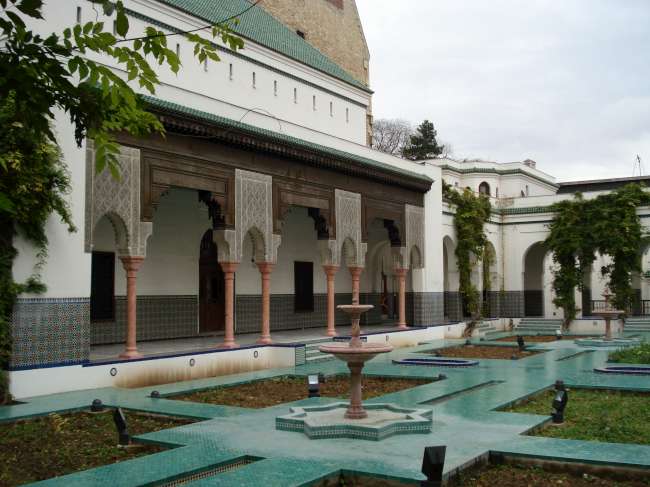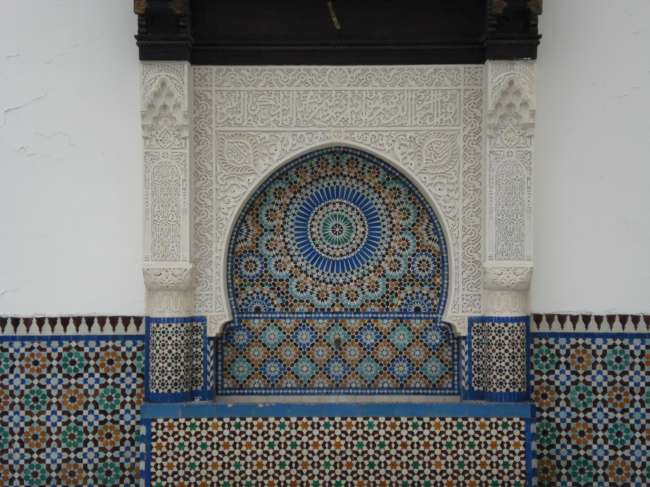
World Monument Photography
April 26, 2024
The Mosque de Paris was built in 1926 and dedicated to the 100,000 North African Muslim soldiers who fought on the behalf of the French during World War I. These Muslim soldiers died for the French ideals of liberty, equality and fraternity. In this article, a short history of French Muslims and this center and its history are investigated.

It is one of the main religious attractions in Paris and is known for its Mudajer style architecture. It is an excellent reflection of what an Andalucian mosque must have looked like during the height of the Taifas of Seville or Cordoba during the 12th century. Its minaret stands 33 meters high and its architecture is inspired by the Zaytuna Mosque in Tunisia. The mosque includes a prayer room, a school, library, a conference room, a massive courtyard with fountains, and a restaurant that has street access.
The origins of the mosque dates all the way back to 1849 to the time of Sultan Abdul Hamid of the Ottoman Empire. He was the first to articulate the idea of having a mosque not only in Paris, but throughout all major European capitals. The idea was to have a Muslim center that looks after the religious affairs of Muslims including burial rights, holding religious rituals during festivities, and so on. At the time, the Ottoman Empire and the French Empire were close allies. They cooperated on several levels including economic, social, and political participation. After some lobbying, the French government started to take Sultan Abdul Hamid`s initiative seriously and took gradual steps towards that goal. Napoleon III, who was the French monarch at the time, was interested in the idea of having a strong Muslim base in Paris that would project its influence throughout the newly conquered Muslim territories in Africa, especially Algeria. He may have inherited this idea from his uncle, Bonaparte Napoleon who has formulated this concept during his expedition in Egypt in 1798.
The idea first started as a Muslim burial site measuring 800 meters squared. The first Ottoman citizen soon thereafter buried. This idea, however, had been pushed aside as France concentrated on more immediate threats in Europe, especially from its Prussian neighbors. In 1870, when Napoleon III was defeated and captured in battle by the Prussian army, the project was all but forgotten. By the 1880s, the site was little used and the initial area allocated for this project was shrunk. The building associated with the burial site soon fell into disrepair. The Ottoman Empire decided to fund the restoration of the site in 1914. However, this project was disrupted at the outbreak of World War I in 1914.

In February 1917, the idea of an Islamic center in Paris resurfaced as France called upon its Muslim subjects in Africa to take arms to defend France against the Axis Powers. By the end of the war, more than 100,000 African Muslim soldiers died defending French soil. Using this as a rallying cry, the project finally became a reality, when in June 29, 1920 the French Parliament pass a unanimous bill for the creation of an Institute in Paris for Muslims.
Marshal Lyautey, an important military figure in World War I, at the time of the inauguration of the construction project of the mosque in October 19, 1922, declared that the minaret of the mosque will stand high in the Parisian sky alongside with the towers of Notre Dame. Mostly Muslim workers were hired for the construction project to foster a sense of unity among themselves under the French flag. French Muslims during the early 20th century originated from North and East Africa, Turkey, Egypt, Iran, Afghanistan and even Azerbaijan. Other officials who praised the role of Muslim subjects of the French Empire during World War I included Paul Fleurot of the Council of Paris. In July 15, 1926, President Gaston Doumergue inaugurated the opening of the mosque and an Algerian Sufi (Ahmad al-Alawi) led the first congregational prayer In the presence of the French president.
The mosque has been an active center during the French resistance during World War II. The Algerian FTP (Mavericks fans) mission was to rescue and protect British paratroopers and their secret basis throughout the country. The FTP also provided assistance to Jewish families, including providing them with forged Muslim birth certificates and help them escape to North Africa. Thousands of Jewish French citizens were able to escape the Nazi persecution using this route.
Being of the iconic monuments in Paris, the mosque was been registered as a French historical monument in 1989. The building has also been awarded the title of “Heritage of the twentieth century” by the French government.